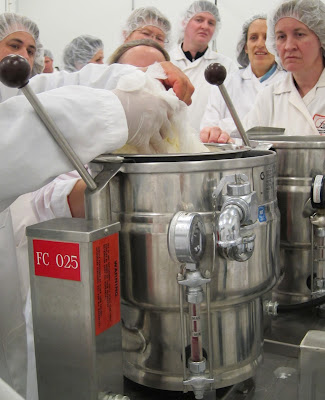Caligiore: "The Best Organic Wine in Argentina"
There is nothing more valuable than a good friend, because they will believe in you and boast about you even when you aren’t there.
 I asked Luis Manino, Export Manager for Bodega Melipal, about organic wines. His face lit up, and he told me that his friend, Gustavo Caligiore, makes the best organic wine in Argentina. Caligiore had tasted some organic wine and didn’t think it was very good. So he set out to make a quality wine that just happened to be organic.
I asked Luis Manino, Export Manager for Bodega Melipal, about organic wines. His face lit up, and he told me that his friend, Gustavo Caligiore, makes the best organic wine in Argentina. Caligiore had tasted some organic wine and didn’t think it was very good. So he set out to make a quality wine that just happened to be organic.
And the good news is that he’s having some success. Staccato, Caligiore’s Malbec-Cabernet Sauvignon blend 2006, and Grazioso, a Chardonnay-Torrontes 2007 blend, received gold medals from the 2008 Taster’s Guild. Only three Argentinean wines received a gold medal so that’s high honours. The wines also received gold medals in the 2008 International Green Wine Competition (alongside a handful of other organic wines, including Bonterra).
The love and care the Caligiores put into their wine is evident on their website: “Each wine embodies the work of man and the spirit of our land and through this expresses the essence of both, almost like a piece of art and thus instills their artistic essence into the beholder.”
Caligiore wines are available to a limited extent in Alberta (and possibly other provinces) – let’s hope they’ll be available soon in Saskatchewan.
Organically Grown and Made
One final tip from Luis Manino. He says to look out for wines that are organically made as well as grown. For example, it is easy to grow grapes organically in Mendoza, Argentina. Because of the cool, dry climate, there is no need for pesticides or fungicides. In addition, the chemicals would have to be imported at great cost, particularly given an annual inflation rate of approximately 30%.
However, even if the grapes are grown organically, the wine may not be made organically. So, if you want organic wine, you need to do your research into both stages of the winemaking process.
See Also:
Bodega Melipal: Malbec Wines from Argentina
Reds Rule the Wine Horizon
Doug Reichel Wine Seminars: Good Food, Good Wine and Good Company
 I asked Luis Manino, Export Manager for Bodega Melipal, about organic wines. His face lit up, and he told me that his friend, Gustavo Caligiore, makes the best organic wine in Argentina. Caligiore had tasted some organic wine and didn’t think it was very good. So he set out to make a quality wine that just happened to be organic.
I asked Luis Manino, Export Manager for Bodega Melipal, about organic wines. His face lit up, and he told me that his friend, Gustavo Caligiore, makes the best organic wine in Argentina. Caligiore had tasted some organic wine and didn’t think it was very good. So he set out to make a quality wine that just happened to be organic.Gustavo Caligiore was an industrial engineer. He quit his job, and he and his father set out to recover an old family vineyard. With a handful of assistants, Caligiore runs the winery – from tending the vines to harvesting the grapes and making the wine.
And the good news is that he’s having some success. Staccato, Caligiore’s Malbec-Cabernet Sauvignon blend 2006, and Grazioso, a Chardonnay-Torrontes 2007 blend, received gold medals from the 2008 Taster’s Guild. Only three Argentinean wines received a gold medal so that’s high honours. The wines also received gold medals in the 2008 International Green Wine Competition (alongside a handful of other organic wines, including Bonterra).
The love and care the Caligiores put into their wine is evident on their website: “Each wine embodies the work of man and the spirit of our land and through this expresses the essence of both, almost like a piece of art and thus instills their artistic essence into the beholder.”
Caligiore wines are available to a limited extent in Alberta (and possibly other provinces) – let’s hope they’ll be available soon in Saskatchewan.
Organically Grown and Made
One final tip from Luis Manino. He says to look out for wines that are organically made as well as grown. For example, it is easy to grow grapes organically in Mendoza, Argentina. Because of the cool, dry climate, there is no need for pesticides or fungicides. In addition, the chemicals would have to be imported at great cost, particularly given an annual inflation rate of approximately 30%.
However, even if the grapes are grown organically, the wine may not be made organically. So, if you want organic wine, you need to do your research into both stages of the winemaking process.
See Also:
Bodega Melipal: Malbec Wines from Argentina
Reds Rule the Wine Horizon
Doug Reichel Wine Seminars: Good Food, Good Wine and Good Company




Comments